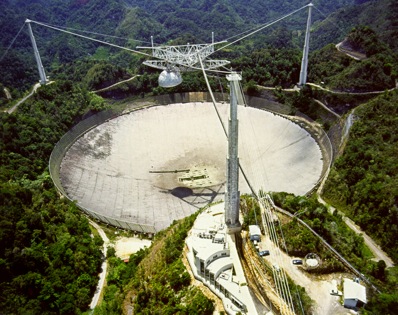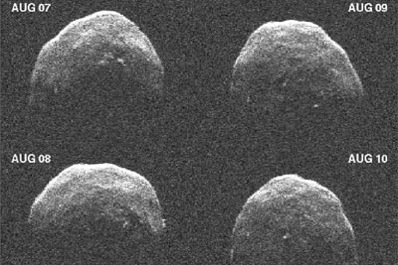



|

|

Glowing report brightens Arecibo's future
DR EMILY BALDWIN
ASTRONOMY NOW
Posted: September 30, 2009


The Arecibo Observatory provides “unmatched precision and accuracy” in detecting asteroids or comets that could hit the Earth, says a report by the National Academy of Sciences that could help secure the observatory’s future.
 The Arecibo Observatory, located in Puerto Rico, is the world's largest and most sensitive radio telescope. Image: NAIC - Arecibo Observatory, a facility of the NSF.
The Arecibo Observatory, located in Puerto Rico, is the world's largest and most sensitive radio telescope. Image: NAIC - Arecibo Observatory, a facility of the NSF.
The world-famous 305-metre radio telescope, which is operated by Cornell University, has unrivaled capabilities for taking outstandingly clear and detailed pictures of Near Earth Objects (NEOs), a quality that was praised in the Near-Earth Object Surveys and Hazard Mitigation Strategies report. The report was welcome news for Cornell officials who await a decision on the future funding allocation for the observatory.
A cloud first fell on Arecibo in November 2006 when the National Science Foundation (NSF) recommended budget cuts that would see the facility’s operating budget reduced from 10.5 million dollars to eight million over three years, further diminishing to just four million by 2011. Such a reduction would inevitably result in the closure of the facility.
 Arecibo Observatory radar images of asteroid 1992 UY4, which has a diameter of 2 kilometers, made from four days' observation in August 2005. Image: Lance Benner/Jet Propulsion Laboratory.
Arecibo Observatory radar images of asteroid 1992 UY4, which has a diameter of 2 kilometers, made from four days' observation in August 2005. Image: Lance Benner/Jet Propulsion Laboratory.
The Earth has been subject to bombardment by asteroids and comets for billions of years, and since the suggestion that the dinosaurs were wiped out in a massive asteroid impact 65 million years ago, scientists have considered the effects of future impacts as a very real risk. The threat has been highlighted by asteroid activity in the last one hundred years – the explosion of an object in the Earth's atmosphere over Siberia in 1908 flattened some 2,000 square kilometres of forest and numerous smaller fireball events have occurred since. Three-metre wide asteroid 2008 TC3 caught the limelight in October 2008 when it burnt up over the desert of Sudan, having been detected less than 24 hours before impact; a solemn reminder of how an asteroid impact could take the Earth by surprise without any considerable warning.
Now, NASA is dedicated to locating and tracking at least 90 percent of all NEOs that measure 140 metres across and above, by 2020. Current NASA surveys are not sufficient to meet this goal, the report says, so the importance of Arecibo's input to NEO detection might force decisions that work in the observatory's favour.
“The Arecibo planetary radar system provides by far the best imagery and tracking data for NEOs, short of sending a spacecraft. It is hard to imagine that we will deliberately give up such a capability,” says Don Campbell, director of Arecibo’s parent organisation, the National Astronomy and Ionosphere Center. “If the survey committee had not come out that strongly, it would have virtually ruled out any funding. [The report] was a necessary, but not sufficient condition to get funding from either NASA or NSF.”
A final report is due in December, and only time will tell what the impact is on funding for Arecibo.
|

|

|

|
|



